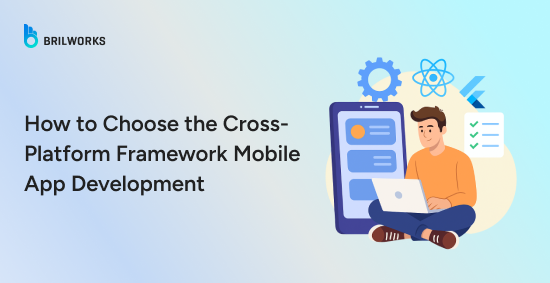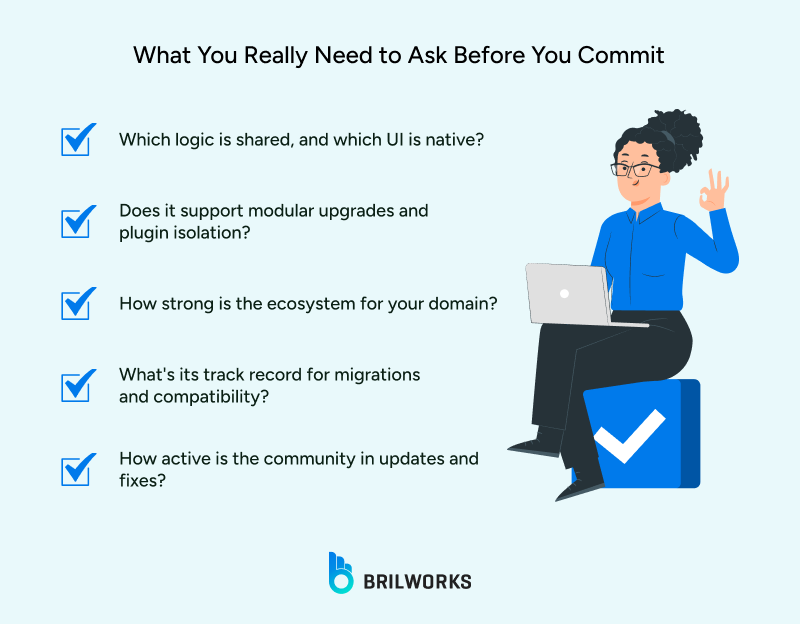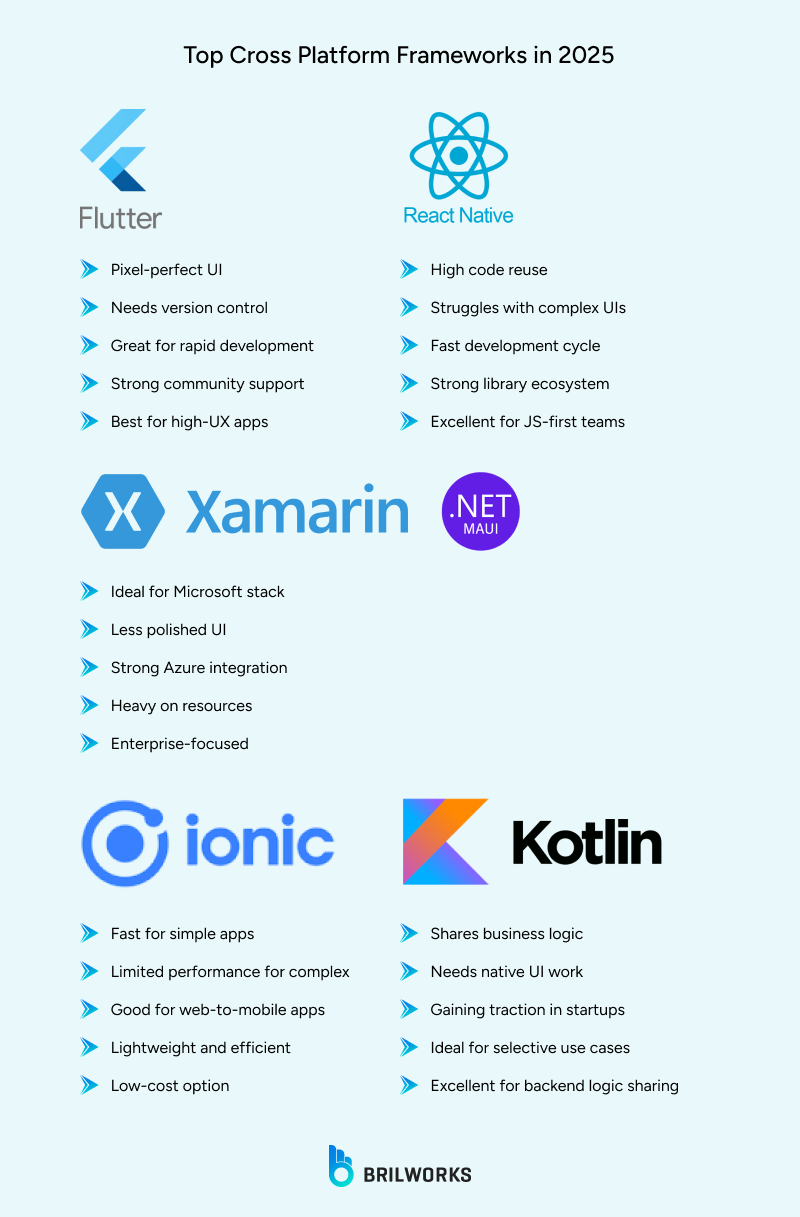COOPERATION MODEL
ARTIFICIAL INTELLIGENCE
PRODUCT ENGINEERING
DevOps & Cloud
LOW-CODE/NO-CODE DEVELOPMENT
INDUSTRY
FRONTEND DEVELOPMENT
CLOUD DEVELOPMENT
MOBILE APP DEVELOPMENT
LOW CODE/ NO CODE DEVELOPMENT
EMERGING TECHNOLOGIES








When David, CTO of a mid-sized logistics company, first pitched the idea of “one app to rule them all,” he was met with skepticism. “You can’t possibly get native performance across iOS and Android with a single codebase,” one of his engineers scoffed. Yet six months later, their app launched on both platforms, and the dev team was managing a single repo. The cost came in at half what a full native rewrite would’ve demanded.
In 2025, stories like David’s are becoming everyday truth. Cross-platform frameworks have matured beyond experiments. Now they’re strategic tools in a B2B development. But the nuance lies in which framework you pick, because that decision will echo through maintainability, performance, and your company’s ability to pivot in the future.
Let’s walk through how a product leader should think, step by step, about selecting the right cross-platform framework in 2025.
In 2025, mobile is foundational. Whether you’re in fintech, health, logistics, or even B2B SaaS. Global mobile app revenue is projected to exceed $613 billion this year, and smartphone penetration has climbed past 7.3 billion users globally. For companies targeting clients, ignoring mobile is rewriting your own obsolescence into the roadmap.
Cross-platform development has evolved from a “cost hack” into a competitive play. The cross-platform frameworks market itself is set to reach USD 546.7 billion by 2033 at a ~20% CAGR. According to developer surveys, 46% of global developers include Flutter in their stack in 2024, and React Native holds a strong 32% share. That momentum signals more than hype.
See Also: The Hidden Costs of Outsourcing Mobile App Development [How to Reduce Them]
Still, the move isn’t without risk. In 2024, the Sonos app rewrite fiasco (using Flutter) made headlines: the company couldn’t rollback their buggy release, and users were stranded. It’s a cautionary tale: pickability, upgrade paths, stability, all matter more than promises. In 2025, building for the future means asking hard questions now.
Imagine two companies, AlphaFin and BetaLogi. Both decide to adopt cross-platform frameworks. AlphaFin treats it like a silver bullet and layers in features without architectural discipline. BetaLogi, on the other hand, designs modular architecture first, then picks a framework that fits.
A year later, AlphaFin’s app chokes under feature bloat and platform quirks. BetaLogi, however, scales confidently, rolls out updates smoothly across iOS and Android, and pivots into a desktop/web version with minimal rework.
The moral: the framework is a tool, not the strategy. Your success depends on how well you align your architecture, team, and use cases before choosing. The framework must serve your roadmap, not the other way around.

Past checklist? Forget it. In 2025, decision-makers ask:
Which business logic must be shared, and which UI must remain native?
Does the framework support modular upgrades & plugin isolation?
How strong is its ecosystem for your domain (IoT, AR, enterprise integration)?
What’s the track record for long-term version migrations and backward compatibility?
What’s the community vitality (not in stars) but in bug fixes, plugin updates, and third-party backing?
These are the levers that determine whether your app will be a burden or a strategic backbone.
Let’s look at where each major framework stands in 2025, with real strength and real scars.

Flutter continues to be the favorite in many dev teams. Its rendering engine gives you pixel-perfect control across platforms. That’s why companies with demanding UX requirements lean heavily on it. But 2024’s Sonos story shook confidence. One public voice summed it: “They were effectively locked out of rolling back their release.” That means you must bake in feature flags, fallback strategies, and control over versioning if you pick it. Still, its tooling, hot reload, and support for new rendering paradigms make it a top choice for aggressive product roadmaps.
React Native in mobile development has quietly re-entered the race in 2024. Shopify’s rewriting of their mobile app claimed 86% code reuse across Android and iOS, eliminating much of the old “bridge” overhead. Also, React Native’s redesign over the past year has improved performance and stability.
For JS-first teams, it’s a natural choice. Its third-party library ecosystem is unmatched, and the community is reenergized. Still, heavy-use UI or animation complexity can stress its architecture if not carefully tuned.
In May 2024, Xamarin’s official support ended, but .NET MAUI stepped in as its successor. For organizations already invested in Microsoft’s stack, this is a compelling path: shared code, deep Azure integration, strong tooling in Visual Studio.
But, It’s heavier, and UI polish is not its strongest suit. Use it where enterprise integration, security, and existing C# skills are your competitive advantage.
Ionic (and variants like Cordova) still serve a purpose for content-driven apps, dashboards, web-to-mobile conversion. The performance ceiling is lower, but if your app is essentially a polished web view with occasional native API touches, Ionic can deliver fast and lean.
In 2025, Progressive Web Apps (PWAs) are seeing renewed interest, but they can’t yet replace full native capabilities for many verticals.
If your goal is to share business logic without forcing UI conformity, Kotlin Multiplatform (KMP) is gaining traction. It allows you to write core models, service layers, domain logic once, and keep native UIs per platform. Netflix and Square have used this approach selectively. But the catch is: UI still needs native work, and plugin maturity is growing but not yet universal.
Focusing only on frameworks is like choosing yesterday’s tools. What matters more are trends. Below are the shifts that will amplify or sink your cross-platform bet.
GitHub Copilot, CodeWhisperer, IntelliCode are no longer experiments. In 2025, these tools assist developers by generating scaffolding, catching edge-case bugs, and speeding up prototyping. That means developers can ship features faster, but also introduces the risk of Frankenstein code unless guarded by architecture discipline.
You can’t release iOS and Android apps from two different pipelines and hope for consistency. Tools like Codemagic, Bitrise, or GitHub Actions now support multi-platform orchestration that can build, test, and deploy in parallel. That pipeline consistency is the backbone of scaling updates.
Now clients expect accessibility features (e.g. screen readers), encryption, and auditability built in. Frameworks that support these out-of-box save you months of retro work.
Apps are no longer monoliths. They’re increasingly expected to download features on demand, switch modules, and adapt dynamically. Combine that with edge computing, on-device AI, and modular architecture, and your framework better play nicely with it.
Let me walk you through a fictional but grounded story. David’s logistics company already had a web portal and backend in Node.js + GraphQL. They hired a small mobile team and had to deliver both a driver and client app. Their constraints:
UI is critical (maps, live tracking, scanning, AR overlays)
Backend logic (routes, pricing, notifications) must be shared
They foresee expanding to desktop and web later
Security and compliance (GDPR, ISO) are non-negotiable
They prototyped two paths:
Flutter: Full shared UI and logic.
Kotlin Multiplatform + native UIs: Shared logic but separate UIs.
In early benchmarks, Flutter delivered smooth maps and transitions. But David’s team worried about future desktop/web expansion and the fact that UI complexity would balloon. Also, a failed Sonos release haunted them.
Instead, they picked a hybrid: core logic in KMP, and UI parts built natively or via Flutter modules where needed. This way, they get the best of both: full UI reuse where safe, and native polish where needed. Over time, they phased more UI into Flutter modules as the team gained confidence.
A year in, their app supports offline mapping, live tracking, payment, and admin dashboards. Their dev runway is predictable, and updates roll out across iOS/Android with shared logic patches. They even started a web dashboard by reusing much of the same backend models. It’s not perfect, but it’s sustainable. That kind of compromise is often wiser than chasing a “one-size-fits-all”.
See Also: GraphQL vs REST
Yes, there are apps that defy easy cross-platform fit:
AR/VR, heavy 3D rendering
Low-latency real-time (like audio mixing, high-frequency finance)
Deep OS integrations (custom sensors, hardware modules)
In those cases, native (or hybrid with native modules) still has a place, especially for performance-sensitive subsystems. But even there, you can adopt a modular approach: use cross-platform for most features, and drop into native where critical.
Plugin quality matters more than framework.
A good plugin ecosystem saves months of reinvention.
Version migration path is a cost. Frameworks that force you to rewrite or fork on major versions will bleed resources.
Team culture and skillset matters more than theoretical “speed”. A strong JS team may deliver faster with React Native than a weak team struggling with Dart.
Fallback and rollback strategy is non-negotiable.
Look at adjacent platforms: desktop, web, embedded. If your future roadmap includes those, pick a framework that can stretch.
Here’s how you could structure your decision narrative:
Start with your business & constraints (did we need UI shared? Web later? Native modules?)
Prototype two paths, even small ones, to measure performance, plugin gaps, and dev speed.
Scan ecosystem health: plugin freshness, issue backlogs, version stability.
Plan for modular fallback: never commit all UI into one layer too early.
Design your release & rollback strategy before writing feature code.
Monitor metrics continuously.
Iterate your selection: frameworks evolve. Be open to migrating or rebalancing.
You won’t find a perfect framework. But you can find the one that fits your roadmap, team dynamics, and risk envelope. In David’s story, the company didn’t win by chasing “all UI shared.” It won by being pragmatic, modular, and strategically flexible. You too can pick your cross-platform adventure, not for the tech’s sake, but for your business’s next chapter.
Get In Touch
Contact us for your software development requirements
Get In Touch
Contact us for your software development requirements